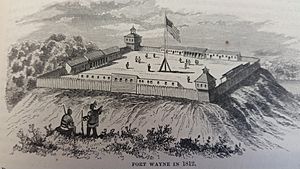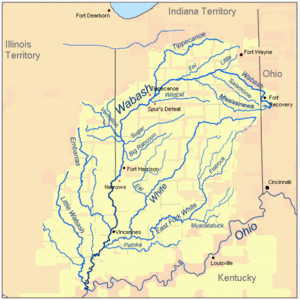Siege of Fort Wayne facts for kids
Quick facts for kids Siege of Fort Wayne |
|||||||
|---|---|---|---|---|---|---|---|
| Part of the War of 1812 | |||||||
 Fort Wayne |
|||||||
|
|||||||
| Belligerents | |||||||
| Miami Potawatomi |
|||||||
| Commanders and leaders | |||||||
| Chief Winamac Chief Wannangsea |
James Rhea, Philip Ostander, William Henry Harrison |
||||||
| Strength | |||||||
| 500 warriors | 100 (garrison) 3,000 (relief force) |
||||||
| Casualties and losses | |||||||
| about 25 killed | Hundreds | ||||||
The Siege of Fort Wayne was a battle that happened from September 5 to 12, 1812. It took place during the War of 1812 in what is now Fort Wayne, Indiana. The fight was between American soldiers defending Fort Wayne and a group of Potawatomi and Miami warriors. These Native American groups were supported by British troops.
The conflict started on September 5 when warriors led by Chiefs Winamac and Five Medals attacked two American soldiers. Over the next few days, the Native Americans burned buildings and crops near the fort. They also launched attacks from outside the fort walls. Chief Winamac and his warriors left on September 12. They left because a large group of American soldiers, led by Major General William Henry Harrison, was coming to help.
The attack on Fort Wayne was one of several attacks on American outposts in September 1812. Other attacks happened at Fort Harrison, Pigeon Roost, and Fort Madison.
Why Did the Siege Happen?
Fort Wayne was built in 1794 by American forces. It was set up at the end of the Northwest Indian War. The fort was meant to show American power in an area with many Native American towns. This area was known as Kekionga.
A big reason for the Native American resistance was the Treaty of Fort Wayne in 1809. This treaty gave about 30 million acres of Native American land to American settlers. This land was in the areas of Illinois and Indiana. Also, the Battle of Tippecanoe in 1811 kept tensions high. This battle was between Native American nations and American settlers.
Before 1812, Fort Wayne was not in good shape. It was a frontier outpost in a busy Native American area. The soldiers, called the garrison, were often disobedient. Many buildings were falling apart, and supplies were low. The fort's leader was Captain James Rhea.
The soldiers at Fort Wayne learned that Fort Dearborn had fallen on August 26. A soldier named Corporal Walter Jordan escaped and brought the news. On August 28, a local trader named Stephen Johnston was killed near the fort. This news made the soldiers worried. An Indian agent, John Johnston, sent a Shawnee leader named Captain Logan to help. He helped move local women and children to Ohio, which was 20 miles away.
In September 1812, warriors from the Potawatomi and Miami nations gathered around Fort Wayne. They were led by Chiefs Winamac and Five Medals. The fort had about 70 soldiers and some civilians inside. Captain James Rhea sent letters asking for help from John Johnston and Ohio Governor Return Meigs. Rhea also invited Native American leaders into the fort several times. He wanted to talk about peace.
The Attack Begins
On the morning of September 5, 1812, the siege began. Chief Winamac's forces attacked two soldiers who were returning from an outhouse. The Native Americans then attacked the fort from the east side. They burned the homes in the nearby village. The Native Americans even built two fake wooden cannons. They hoped to trick the American soldiers into thinking the British had arrived with real artillery.
Captain Rhea said he was sick and went to his room. The fort's Indian Agent, Benjamin Stickney, was also recovering from an illness. But he took command of the fort with Lieutenants Daniel Curtis and Phillip Ostrander. The Native American forces attacked the fort twice. Then they pulled back, waiting for British forces to arrive with light artillery.
That evening, Chief Winamac and thirteen of his men came to the fort to parley, which means to talk. They were allowed inside. As the leaders talked, Winamac pulled out a hidden knife. He tried to attack Stickney but failed. Winamac was then removed from the fort. Soon after, around 8:00 PM, the Native American forces started attacking the fort again. Winamac's forces tried to set the fort on fire. The soldiers inside tried to keep the walls wet. They also fired back with muskets and howitzers. The battle continued until about 3:00 PM on September 6. Then the Native American forces moved to a safe distance. The fighting started again at 9:00 PM that night.
Help Arrives!

Efforts to help Fort Wayne were already underway. News of the loss of Fort Michilimackinac, Fort Dearborn, and Fort Detroit had reached American military leaders. General James Winchester was the commander of the Northwestern Army. However, Kentucky Governor Charles Scott had recently made Indiana Territory Governor William Henry Harrison a Major General. Harrison was given permission to help Fort Wayne.
Harrison quickly gathered a militia force of 2,200 men. A militia is a group of citizens who can act as soldiers. He marched north towards the fort. A small group of scouts, led by William Oliver and Shawnee leader Captain Logan, reached Fort Wayne. They got into the fort during a break in the fighting. They told the soldiers that help was coming. Then they rode back through the siege to tell Harrison that the fort was still under American control.
Harrison also heard that a force of 400 Native Americans and 140 British soldiers was heading towards Fort Wayne. This group was led by Tecumseh. Harrison rushed to get to Fort Wayne before Tecumseh and the British. By September 8, Harrison and his 2,200 troops reached a village on the St. Marys River. There, 800 men from the Ohio militia joined them.
On September 11, Winamac tried one last attack on Fort Wayne, but it failed. On September 12, the attack was called off. Winamac's forces crossed the Maumee River and disappeared into the woods. Harrison's army arrived later that day. Winamac's warriors did not try to stop them. The Native American and British forces retreated into Ohio and Michigan Territory.
After the British had captured Detroit, they heard that Native Americans had surrounded an American fort. General Isaac Brock learned that there was a temporary ceasefire in the east. So, he ordered Colonel Henry Procter not to send help for the attack on Fort Wayne.
What Happened After the Siege?
The siege of Fort Wayne made Harrison order attacks on nearby Native American villages. He sent soldiers to attack the Potawatomi villages of Five Medals. He also sent other soldiers to attack Miami villages. These attacks led to the Battle of the Mississinewa in December 1812.
An important Miami Chief named Pacanne had stayed neutral in this war. But after the American attacks, Pacanne openly joined the British. The failed attempts to take Fort Harrison and Fort Wayne, along with Harrison's attacks, made many Native Americans lose confidence. Many of them then joined Tecumseh and his confederacy. There were no major Native American attacks in the Indiana Territory for the rest of the war. The pressure on American settlers only truly lessened after Tecumseh was defeated at the Battle of the Thames.
On September 18, 1812, General Winchester arrived at Fort Wayne. Harrison gave up command to him. Later, Harrison received orders to take back control of Michigan Territory. Harrison's successes made him famous. He soon replaced Winchester as the commander of the North West Army. He planned to use Fort Wayne as a starting point to retake Fort Detroit. This plan led to the Battle of Frenchtown four months later.
After the siege, the council house at Fort Wayne was rebuilt in 1816.


